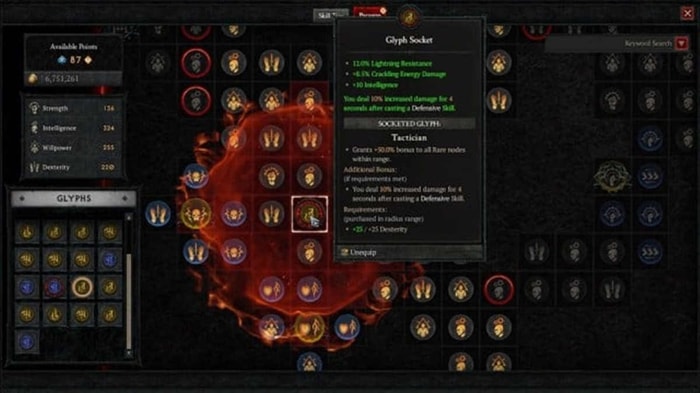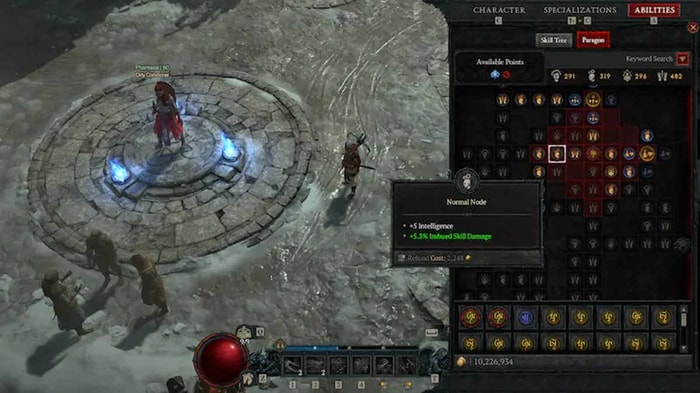Diablo 4 features a vast open world, dynamic events, customizable classes, and a deep endgame system. One of the key aspects of the endgame is the Paragon Board, which allows players to further improve their characters after reaching level 50.
The Paragon Board is a grid of nodes that grant various bonuses to attributes, skills, and combat abilities. Players can unlock and activate these nodes by spending Paragon Points earned by leveling up past level 50. Each class has its own Paragon Board, with different layouts and node types.
However, the Paragon Board is not just a static system. It can be enhanced and modified by using Glyphs, special items that can be slotted into certain nodes called Glyph Sockets. Glyphs are endgame perks that provide additional effects based on their rarity, type, and placement on the board.
How to Get Glyphs
Glyphs are rare items that start dropping after completing the first Capstone Dungeon and gaining access to the Tier 3 world tier. The best way to get Glyphs is by doing Nightmare Dungeons, challenging dungeons requiring a Nightmare Sigil to enter. Nightmare Sigils can be obtained from loot caches, dropped by enemies, or crafted in Kyovashad.
Nightmare Dungeons often drop Diablo 4 Glyphs and gold from elites, chests, and the final boss. The higher the difficulty of the dungeon, the higher the chance of getting better Glyphs. Other ways to get Glyphs include completing Whispers of the Dead for the Tree of Whispers or participating in Helltide events.

How to Use Glyphs
Once you have a Glyph, you can slot it into your Paragon Board by opening the menu and selecting a Glyph Socket. It would help if you unlocked a Glyph Socket by spending Paragon Points on the nodes leading to it. You can swap out Glyphs at any time without any cost.
Each Glyph has a radius and a bonus or set of bonuses that it applies based on its rarity and type. For example, a rare Necromancer "Mage" Glyph has a radius of three on either side, and for every +5 intelligence node unlocked in that area, the skeletal mages get a +3.7% damage bonus. It also has an additional fixed bonus when 40 intelligence is unlocked in the radius.
The radius of a Glyph can be seen by hovering over it and looking for an outline of red nodes surrounding it. The bonus of a Glyph can be seen by hovering over it and reading its description. The bonus can be either fixed or scaled based on the number and type of nodes unlocked in the radius.
Some examples of Glyph types are:
• Combat: These Glyphs enhance combat abilities, such as increasing damage, critical chance, or attack speed.
• Utility: These Glyphs provide useful effects, such as increasing movement speed, resource regeneration, or cooldown reduction.
• Defense: These Glyphs improve survivability, such as increasing health, armor, or resistance.
• Skill: These Glyphs boost specific skills or skill categories, such as increasing duration, damage, or number of summons.
How to Upgrade Glyphs
Glyphs can be upgraded by completing Nightmare Dungeons and interacting with an Awakened Glyph at the end of each dungeon. An Awakened Glyph is a glowing orb with a protective shield around it. By interacting with it, you can allocate XP earned from the dungeon to the Glyph of your choice.
Once a Glyph has enough XP, it will level up and gain stronger effects in the process. The maximum level of a Glyph depends on its rarity. For example, a common Glyph can only be upgraded to level 5, while a legendary Glyph can be upgraded to level 20.
Upgrading a Glyph will increase its radius and bonus accordingly. For example, a common Barbarian "Berserker" Glyph has a radius of two and a bonus of +1% damage for every +5 strength node unlocked in that area at level 1. At level 5, it has a radius of three and a bonus of +1.5% damage for every +5 strength node unlocked in that area.
Upgrading a Glyph also unlocks new bonuses at certain levels. For example, the same "Berserker" Glyph grants an additional +10% damage when 30 strength is unlocked in the radius at level 3. These bonuses are usually more powerful than the base bonus and can significantly affect your performance.

Tips for Using Glyphs
• Choose your Glyphs wisely based on your class, build, playstyle, and preference. Some Glyphs may synergize better with certain skills, attributes, or ordinary Diablo 4 items than others.
• Experiment with different Glyphs and placements to find the optimal combination for your Paragon Board. You can always swap out Glyphs and reset your Paragon Points without any penalty.
• Upgrade your Glyphs regularly to keep up with the increasing difficulty of the endgame. Higher-level Glyphs will provide more benefits and help you overcome tougher challenges.
• Collect as many Glyphs as you can to expand your options and flexibility. You never know when you might want to try a different Glyph or switch to a different build.
Conclusion
Glyphs are an important part of the endgame system in Diablo 4. They allow you to customize and enhance your Paragon Board, affecting your character's power and performance. Using Glyphs wisely, you can create unique and effective builds that suit your playstyle and preference. Have fun exploring the world of Sanctuary and finding the best Glyphs for your character!



